Leadership, Management, Operations Management Report Analysis
VerifiedAdded on 2020/10/22
|17
|6042
|299
Report
AI Summary
This report provides a comprehensive analysis of the roles of leaders and managers, highlighting their key differences and responsibilities within an organization. It explores the application of leadership and management in various situational contexts, including conflict and crisis management, and delves into different leadership theories, such as situational and system leadership. The report also examines the importance of operations management in achieving business objectives, discussing the factors that influence operational decision-making. Through detailed comparisons and practical examples, the report offers valuable insights into effective leadership and management practices, providing a solid understanding of how these elements contribute to organizational success and the efficient production of goods and services.
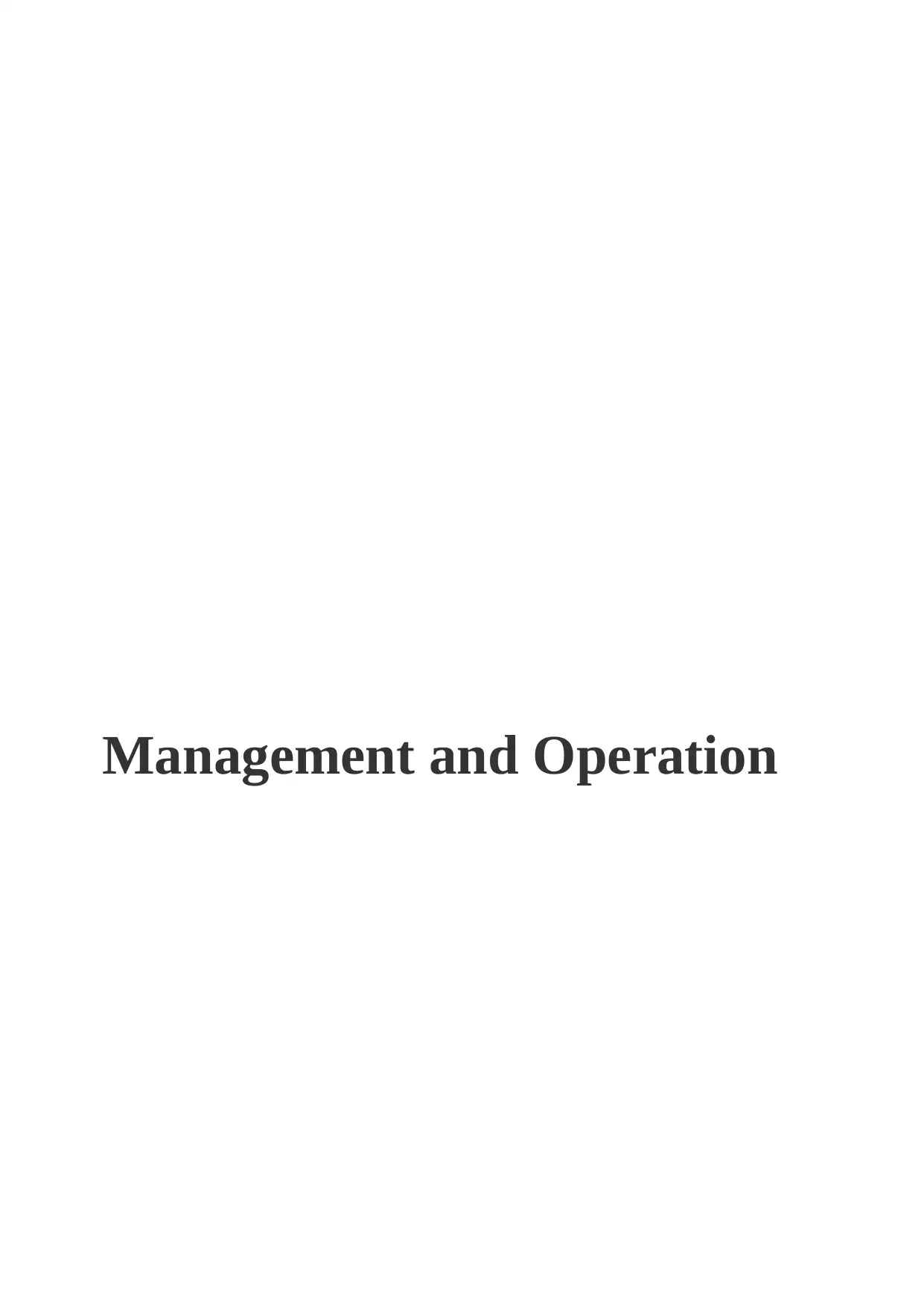
Management and Operation
Paraphrase This Document
Need a fresh take? Get an instant paraphrase of this document with our AI Paraphraser
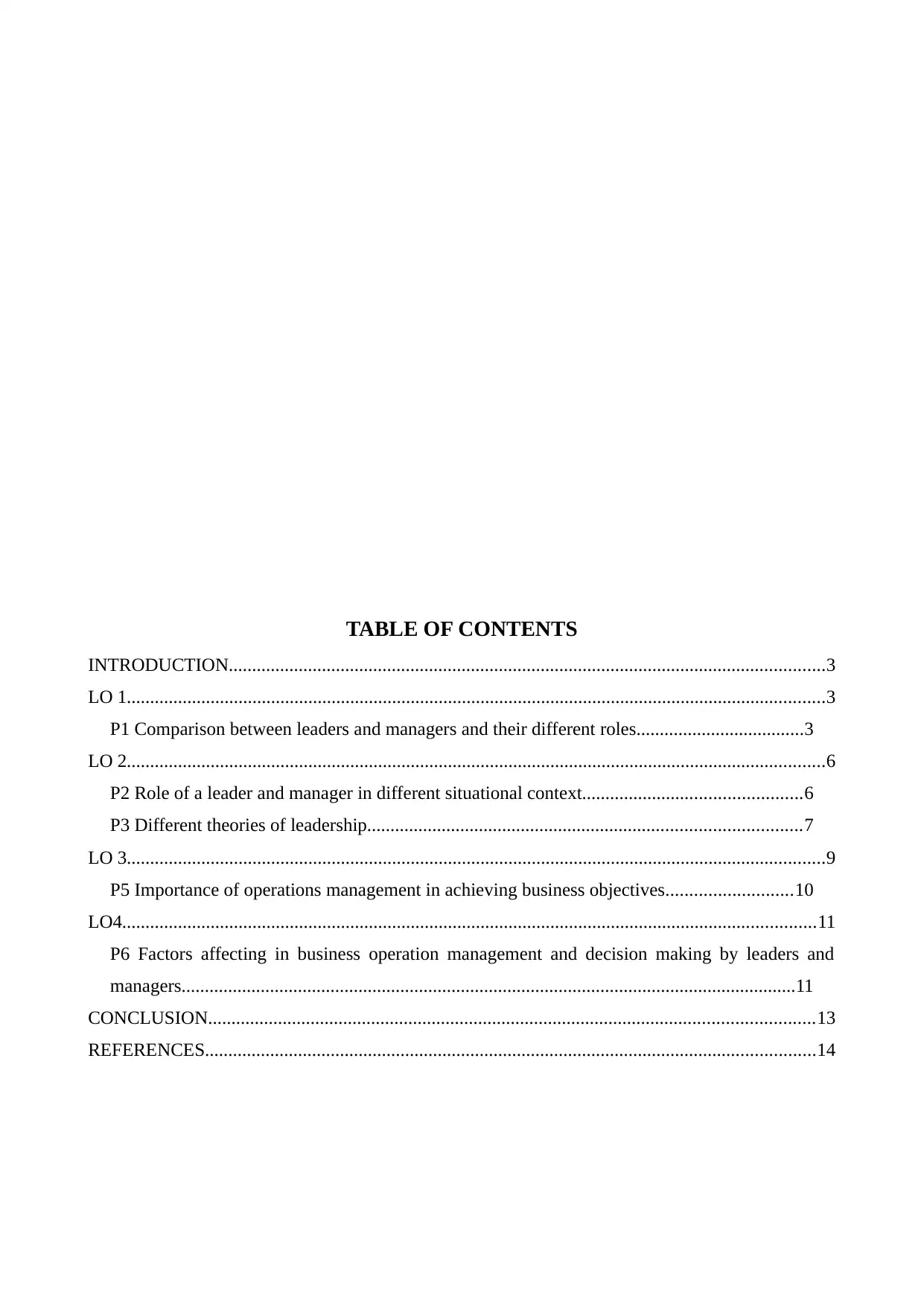
TABLE OF CONTENTS
INTRODUCTION................................................................................................................................3
LO 1......................................................................................................................................................3
P1 Comparison between leaders and managers and their different roles....................................3
LO 2......................................................................................................................................................6
P2 Role of a leader and manager in different situational context...............................................6
P3 Different theories of leadership.............................................................................................7
LO 3......................................................................................................................................................9
P5 Importance of operations management in achieving business objectives...........................10
LO4.....................................................................................................................................................11
P6 Factors affecting in business operation management and decision making by leaders and
managers....................................................................................................................................11
CONCLUSION..................................................................................................................................13
REFERENCES...................................................................................................................................14
INTRODUCTION................................................................................................................................3
LO 1......................................................................................................................................................3
P1 Comparison between leaders and managers and their different roles....................................3
LO 2......................................................................................................................................................6
P2 Role of a leader and manager in different situational context...............................................6
P3 Different theories of leadership.............................................................................................7
LO 3......................................................................................................................................................9
P5 Importance of operations management in achieving business objectives...........................10
LO4.....................................................................................................................................................11
P6 Factors affecting in business operation management and decision making by leaders and
managers....................................................................................................................................11
CONCLUSION..................................................................................................................................13
REFERENCES...................................................................................................................................14
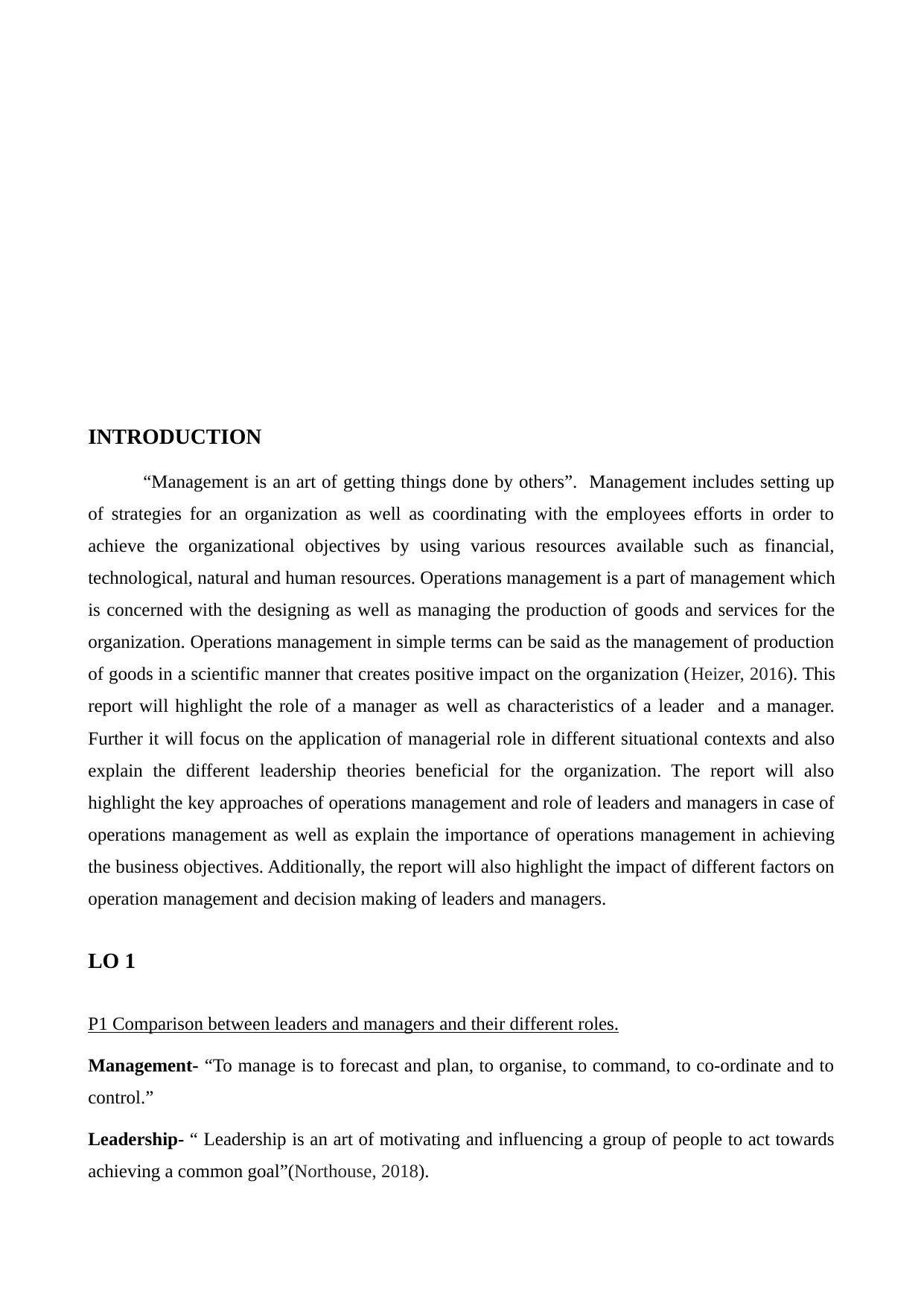
INTRODUCTION
“Management is an art of getting things done by others”. Management includes setting up
of strategies for an organization as well as coordinating with the employees efforts in order to
achieve the organizational objectives by using various resources available such as financial,
technological, natural and human resources. Operations management is a part of management which
is concerned with the designing as well as managing the production of goods and services for the
organization. Operations management in simple terms can be said as the management of production
of goods in a scientific manner that creates positive impact on the organization (Heizer, 2016). This
report will highlight the role of a manager as well as characteristics of a leader and a manager.
Further it will focus on the application of managerial role in different situational contexts and also
explain the different leadership theories beneficial for the organization. The report will also
highlight the key approaches of operations management and role of leaders and managers in case of
operations management as well as explain the importance of operations management in achieving
the business objectives. Additionally, the report will also highlight the impact of different factors on
operation management and decision making of leaders and managers.
LO 1
P1 Comparison between leaders and managers and their different roles.
Management- “To manage is to forecast and plan, to organise, to command, to co-ordinate and to
control.”
Leadership- “ Leadership is an art of motivating and influencing a group of people to act towards
achieving a common goal”(Northouse, 2018).
“Management is an art of getting things done by others”. Management includes setting up
of strategies for an organization as well as coordinating with the employees efforts in order to
achieve the organizational objectives by using various resources available such as financial,
technological, natural and human resources. Operations management is a part of management which
is concerned with the designing as well as managing the production of goods and services for the
organization. Operations management in simple terms can be said as the management of production
of goods in a scientific manner that creates positive impact on the organization (Heizer, 2016). This
report will highlight the role of a manager as well as characteristics of a leader and a manager.
Further it will focus on the application of managerial role in different situational contexts and also
explain the different leadership theories beneficial for the organization. The report will also
highlight the key approaches of operations management and role of leaders and managers in case of
operations management as well as explain the importance of operations management in achieving
the business objectives. Additionally, the report will also highlight the impact of different factors on
operation management and decision making of leaders and managers.
LO 1
P1 Comparison between leaders and managers and their different roles.
Management- “To manage is to forecast and plan, to organise, to command, to co-ordinate and to
control.”
Leadership- “ Leadership is an art of motivating and influencing a group of people to act towards
achieving a common goal”(Northouse, 2018).
⊘ This is a preview!⊘
Do you want full access?
Subscribe today to unlock all pages.

Trusted by 1+ million students worldwide
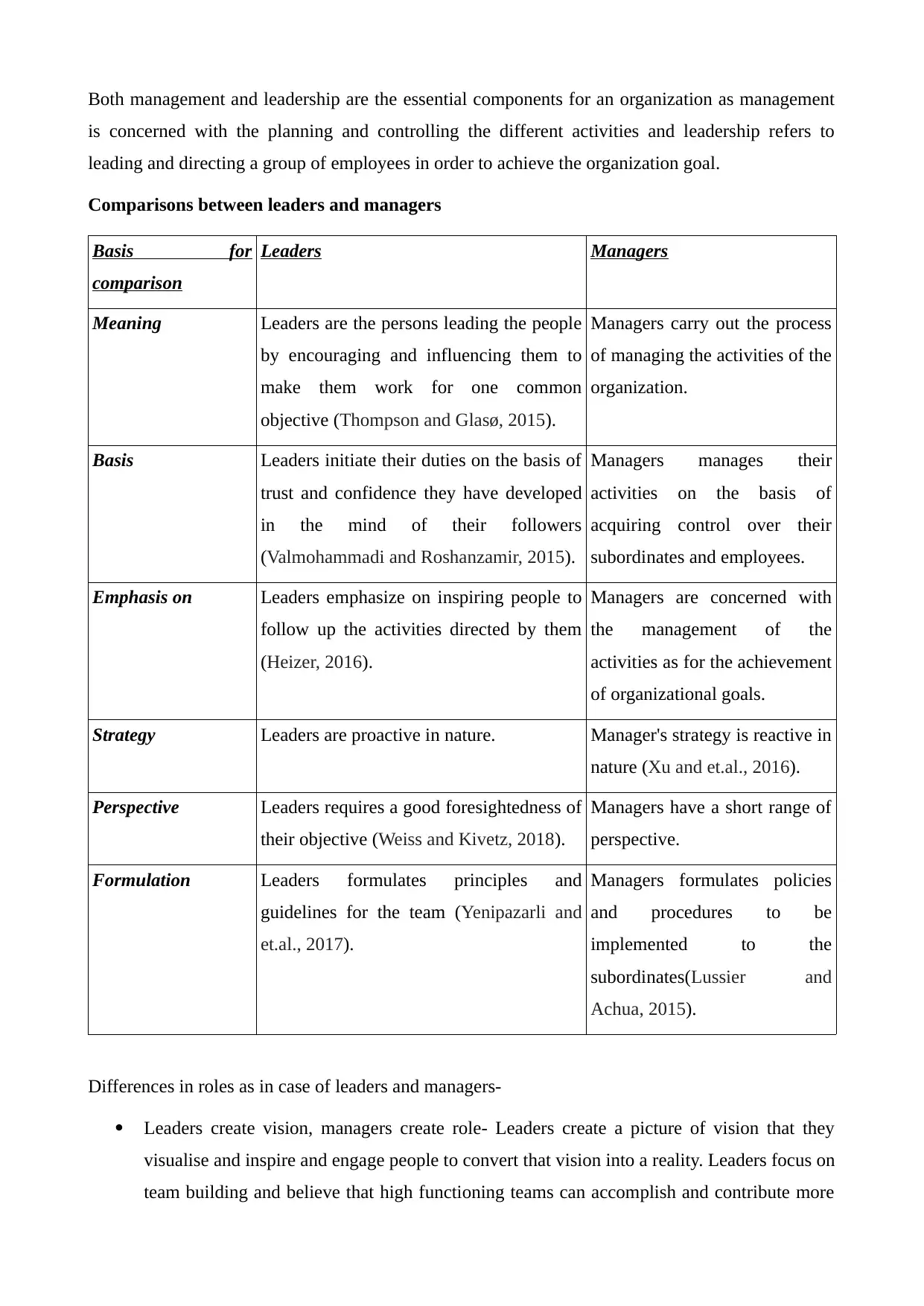
Both management and leadership are the essential components for an organization as management
is concerned with the planning and controlling the different activities and leadership refers to
leading and directing a group of employees in order to achieve the organization goal.
Comparisons between leaders and managers
Basis for
comparison
Leaders Managers
Meaning Leaders are the persons leading the people
by encouraging and influencing them to
make them work for one common
objective (Thompson and Glasø, 2015).
Managers carry out the process
of managing the activities of the
organization.
Basis Leaders initiate their duties on the basis of
trust and confidence they have developed
in the mind of their followers
(Valmohammadi and Roshanzamir, 2015).
Managers manages their
activities on the basis of
acquiring control over their
subordinates and employees.
Emphasis on Leaders emphasize on inspiring people to
follow up the activities directed by them
(Heizer, 2016).
Managers are concerned with
the management of the
activities as for the achievement
of organizational goals.
Strategy Leaders are proactive in nature. Manager's strategy is reactive in
nature (Xu and et.al., 2016).
Perspective Leaders requires a good foresightedness of
their objective (Weiss and Kivetz, 2018).
Managers have a short range of
perspective.
Formulation Leaders formulates principles and
guidelines for the team (Yenipazarli and
et.al., 2017).
Managers formulates policies
and procedures to be
implemented to the
subordinates(Lussier and
Achua, 2015).
Differences in roles as in case of leaders and managers-
Leaders create vision, managers create role- Leaders create a picture of vision that they
visualise and inspire and engage people to convert that vision into a reality. Leaders focus on
team building and believe that high functioning teams can accomplish and contribute more
is concerned with the planning and controlling the different activities and leadership refers to
leading and directing a group of employees in order to achieve the organization goal.
Comparisons between leaders and managers
Basis for
comparison
Leaders Managers
Meaning Leaders are the persons leading the people
by encouraging and influencing them to
make them work for one common
objective (Thompson and Glasø, 2015).
Managers carry out the process
of managing the activities of the
organization.
Basis Leaders initiate their duties on the basis of
trust and confidence they have developed
in the mind of their followers
(Valmohammadi and Roshanzamir, 2015).
Managers manages their
activities on the basis of
acquiring control over their
subordinates and employees.
Emphasis on Leaders emphasize on inspiring people to
follow up the activities directed by them
(Heizer, 2016).
Managers are concerned with
the management of the
activities as for the achievement
of organizational goals.
Strategy Leaders are proactive in nature. Manager's strategy is reactive in
nature (Xu and et.al., 2016).
Perspective Leaders requires a good foresightedness of
their objective (Weiss and Kivetz, 2018).
Managers have a short range of
perspective.
Formulation Leaders formulates principles and
guidelines for the team (Yenipazarli and
et.al., 2017).
Managers formulates policies
and procedures to be
implemented to the
subordinates(Lussier and
Achua, 2015).
Differences in roles as in case of leaders and managers-
Leaders create vision, managers create role- Leaders create a picture of vision that they
visualise and inspire and engage people to convert that vision into a reality. Leaders focus on
team building and believe that high functioning teams can accomplish and contribute more
Paraphrase This Document
Need a fresh take? Get an instant paraphrase of this document with our AI Paraphraser
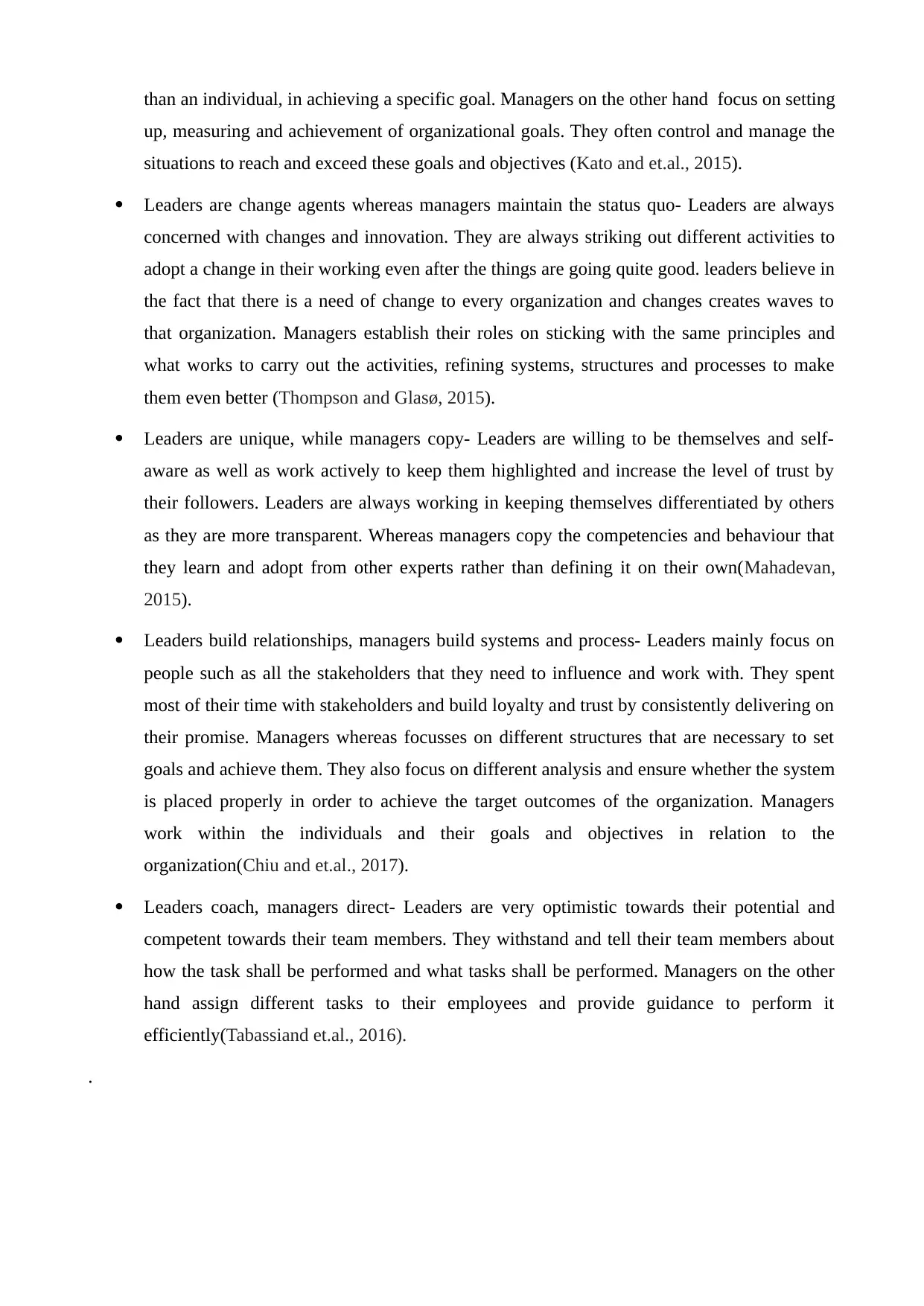
than an individual, in achieving a specific goal. Managers on the other hand focus on setting
up, measuring and achievement of organizational goals. They often control and manage the
situations to reach and exceed these goals and objectives (Kato and et.al., 2015).
Leaders are change agents whereas managers maintain the status quo- Leaders are always
concerned with changes and innovation. They are always striking out different activities to
adopt a change in their working even after the things are going quite good. leaders believe in
the fact that there is a need of change to every organization and changes creates waves to
that organization. Managers establish their roles on sticking with the same principles and
what works to carry out the activities, refining systems, structures and processes to make
them even better (Thompson and Glasø, 2015).
Leaders are unique, while managers copy- Leaders are willing to be themselves and self-
aware as well as work actively to keep them highlighted and increase the level of trust by
their followers. Leaders are always working in keeping themselves differentiated by others
as they are more transparent. Whereas managers copy the competencies and behaviour that
they learn and adopt from other experts rather than defining it on their own(Mahadevan,
2015).
Leaders build relationships, managers build systems and process- Leaders mainly focus on
people such as all the stakeholders that they need to influence and work with. They spent
most of their time with stakeholders and build loyalty and trust by consistently delivering on
their promise. Managers whereas focusses on different structures that are necessary to set
goals and achieve them. They also focus on different analysis and ensure whether the system
is placed properly in order to achieve the target outcomes of the organization. Managers
work within the individuals and their goals and objectives in relation to the
organization(Chiu and et.al., 2017).
Leaders coach, managers direct- Leaders are very optimistic towards their potential and
competent towards their team members. They withstand and tell their team members about
how the task shall be performed and what tasks shall be performed. Managers on the other
hand assign different tasks to their employees and provide guidance to perform it
efficiently(Tabassiand et.al., 2016).
.
up, measuring and achievement of organizational goals. They often control and manage the
situations to reach and exceed these goals and objectives (Kato and et.al., 2015).
Leaders are change agents whereas managers maintain the status quo- Leaders are always
concerned with changes and innovation. They are always striking out different activities to
adopt a change in their working even after the things are going quite good. leaders believe in
the fact that there is a need of change to every organization and changes creates waves to
that organization. Managers establish their roles on sticking with the same principles and
what works to carry out the activities, refining systems, structures and processes to make
them even better (Thompson and Glasø, 2015).
Leaders are unique, while managers copy- Leaders are willing to be themselves and self-
aware as well as work actively to keep them highlighted and increase the level of trust by
their followers. Leaders are always working in keeping themselves differentiated by others
as they are more transparent. Whereas managers copy the competencies and behaviour that
they learn and adopt from other experts rather than defining it on their own(Mahadevan,
2015).
Leaders build relationships, managers build systems and process- Leaders mainly focus on
people such as all the stakeholders that they need to influence and work with. They spent
most of their time with stakeholders and build loyalty and trust by consistently delivering on
their promise. Managers whereas focusses on different structures that are necessary to set
goals and achieve them. They also focus on different analysis and ensure whether the system
is placed properly in order to achieve the target outcomes of the organization. Managers
work within the individuals and their goals and objectives in relation to the
organization(Chiu and et.al., 2017).
Leaders coach, managers direct- Leaders are very optimistic towards their potential and
competent towards their team members. They withstand and tell their team members about
how the task shall be performed and what tasks shall be performed. Managers on the other
hand assign different tasks to their employees and provide guidance to perform it
efficiently(Tabassiand et.al., 2016).
.

LO 2
P2 Role of a leader and manager in different situational context.
Leaders as well as managers plays vital role in different situations that occurs in an
organization(Alavi and Gill, 2017). Some of the situations that occurs most commonly in the
organization are-
Conflicts management- Organizational conflicts is a state of discord caused due to
misunderstanding of the needs, values and interests between two persons of employees in an
organization. There may be several reasons for the conflicts such as dissatisfaction with the fellow
mates, leader as well as other personnels. Conflicts usually results in the loss in efficiency among
the employees to perform tasks as well as disturbs uniformity in the organizational functioning. In
order to resolve and manage these conflicts in the organization the managers and leaders plays an
important role in an organization(Xu and et.al., 2016).
Role of a manager and leader- In this case a leader has to act as a median between the two parties
of conflicts. The main role of the leader is to resolve the temporary occurrence of the conflicts
between the individuals. The leader influence their team members as through his words and his
power of the position. The manager has to take the final decision of the resolution of the conflict as
in favour of the organization policies and procedures. The manager provides the guidelines and
suggests the leaders to initiate a particular solution and the measures to be taken in order to avoid
such condition in the future. In this way the manager and leader establishes their different roles in
managing the conflicts in the organization(Khanna, 2015).
Crises management- Crisis in an organization refers to a disruptive and unexpected event that
causes threats and harms the organization in different manner. The process of dealing with these
crises is termed as crises management. The organization has to deal with various threats before,
during and after their occurrence so as to avoid them from harming the business activities and the
performance of the organizational activities. There are various causes for the crises such as
reduction in sales, reduction in revenues, political issues, natural disasters and many other acts of
complication that threatens the organization. The way in which the organization deals with such
situations and problems, ensures the crisis management of that organization(Noe and et.al., 2017).
Role of a manager and leader- The manager has to take various decisions regarding the
functioning of the activities of the organization during crises situation. The manager has to analyses
P2 Role of a leader and manager in different situational context.
Leaders as well as managers plays vital role in different situations that occurs in an
organization(Alavi and Gill, 2017). Some of the situations that occurs most commonly in the
organization are-
Conflicts management- Organizational conflicts is a state of discord caused due to
misunderstanding of the needs, values and interests between two persons of employees in an
organization. There may be several reasons for the conflicts such as dissatisfaction with the fellow
mates, leader as well as other personnels. Conflicts usually results in the loss in efficiency among
the employees to perform tasks as well as disturbs uniformity in the organizational functioning. In
order to resolve and manage these conflicts in the organization the managers and leaders plays an
important role in an organization(Xu and et.al., 2016).
Role of a manager and leader- In this case a leader has to act as a median between the two parties
of conflicts. The main role of the leader is to resolve the temporary occurrence of the conflicts
between the individuals. The leader influence their team members as through his words and his
power of the position. The manager has to take the final decision of the resolution of the conflict as
in favour of the organization policies and procedures. The manager provides the guidelines and
suggests the leaders to initiate a particular solution and the measures to be taken in order to avoid
such condition in the future. In this way the manager and leader establishes their different roles in
managing the conflicts in the organization(Khanna, 2015).
Crises management- Crisis in an organization refers to a disruptive and unexpected event that
causes threats and harms the organization in different manner. The process of dealing with these
crises is termed as crises management. The organization has to deal with various threats before,
during and after their occurrence so as to avoid them from harming the business activities and the
performance of the organizational activities. There are various causes for the crises such as
reduction in sales, reduction in revenues, political issues, natural disasters and many other acts of
complication that threatens the organization. The way in which the organization deals with such
situations and problems, ensures the crisis management of that organization(Noe and et.al., 2017).
Role of a manager and leader- The manager has to take various decisions regarding the
functioning of the activities of the organization during crises situation. The manager has to analyses
⊘ This is a preview!⊘
Do you want full access?
Subscribe today to unlock all pages.

Trusted by 1+ million students worldwide
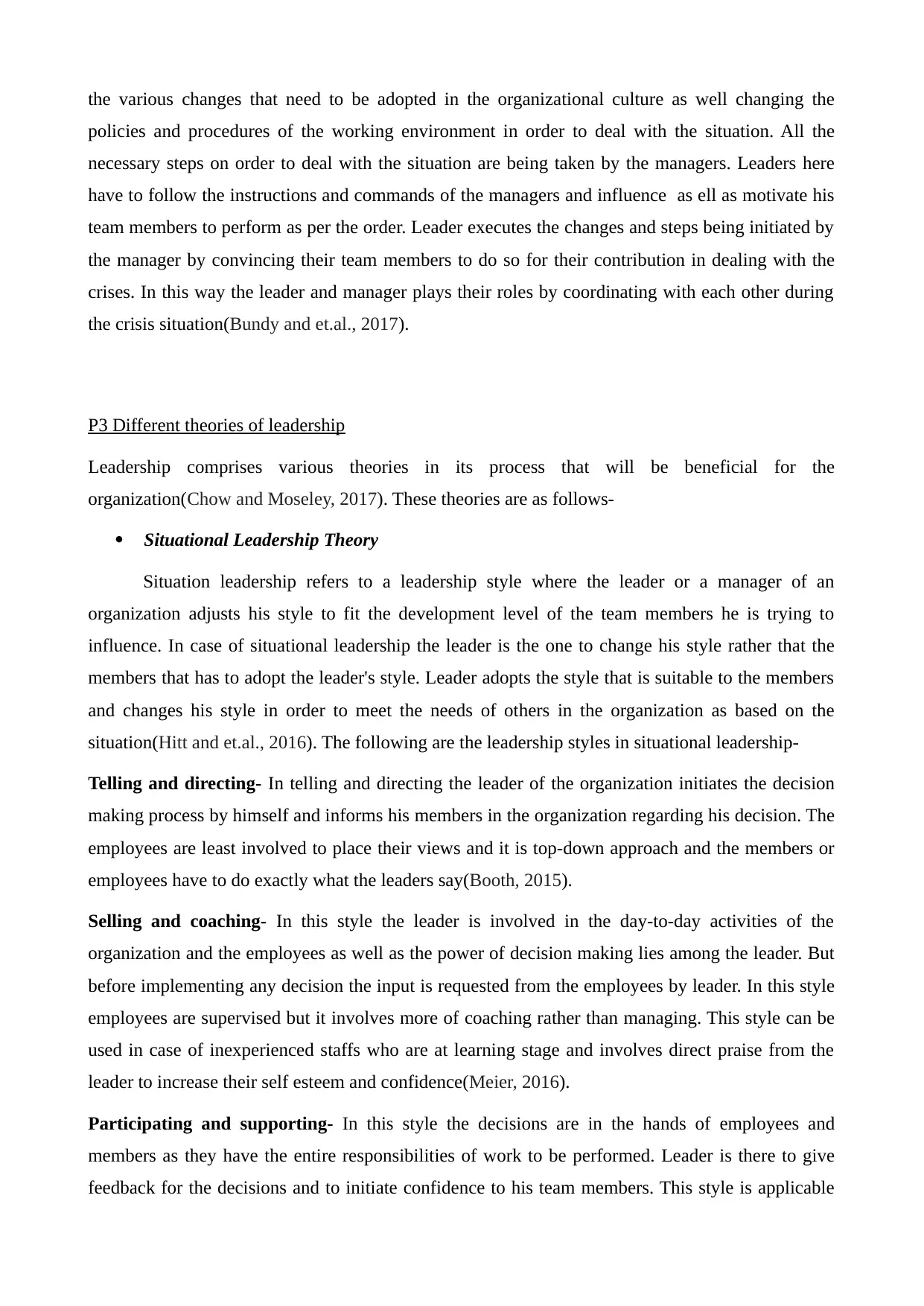
the various changes that need to be adopted in the organizational culture as well changing the
policies and procedures of the working environment in order to deal with the situation. All the
necessary steps on order to deal with the situation are being taken by the managers. Leaders here
have to follow the instructions and commands of the managers and influence as ell as motivate his
team members to perform as per the order. Leader executes the changes and steps being initiated by
the manager by convincing their team members to do so for their contribution in dealing with the
crises. In this way the leader and manager plays their roles by coordinating with each other during
the crisis situation(Bundy and et.al., 2017).
P3 Different theories of leadership
Leadership comprises various theories in its process that will be beneficial for the
organization(Chow and Moseley, 2017). These theories are as follows-
Situational Leadership Theory
Situation leadership refers to a leadership style where the leader or a manager of an
organization adjusts his style to fit the development level of the team members he is trying to
influence. In case of situational leadership the leader is the one to change his style rather that the
members that has to adopt the leader's style. Leader adopts the style that is suitable to the members
and changes his style in order to meet the needs of others in the organization as based on the
situation(Hitt and et.al., 2016). The following are the leadership styles in situational leadership-
Telling and directing- In telling and directing the leader of the organization initiates the decision
making process by himself and informs his members in the organization regarding his decision. The
employees are least involved to place their views and it is top-down approach and the members or
employees have to do exactly what the leaders say(Booth, 2015).
Selling and coaching- In this style the leader is involved in the day-to-day activities of the
organization and the employees as well as the power of decision making lies among the leader. But
before implementing any decision the input is requested from the employees by leader. In this style
employees are supervised but it involves more of coaching rather than managing. This style can be
used in case of inexperienced staffs who are at learning stage and involves direct praise from the
leader to increase their self esteem and confidence(Meier, 2016).
Participating and supporting- In this style the decisions are in the hands of employees and
members as they have the entire responsibilities of work to be performed. Leader is there to give
feedback for the decisions and to initiate confidence to his team members. This style is applicable
policies and procedures of the working environment in order to deal with the situation. All the
necessary steps on order to deal with the situation are being taken by the managers. Leaders here
have to follow the instructions and commands of the managers and influence as ell as motivate his
team members to perform as per the order. Leader executes the changes and steps being initiated by
the manager by convincing their team members to do so for their contribution in dealing with the
crises. In this way the leader and manager plays their roles by coordinating with each other during
the crisis situation(Bundy and et.al., 2017).
P3 Different theories of leadership
Leadership comprises various theories in its process that will be beneficial for the
organization(Chow and Moseley, 2017). These theories are as follows-
Situational Leadership Theory
Situation leadership refers to a leadership style where the leader or a manager of an
organization adjusts his style to fit the development level of the team members he is trying to
influence. In case of situational leadership the leader is the one to change his style rather that the
members that has to adopt the leader's style. Leader adopts the style that is suitable to the members
and changes his style in order to meet the needs of others in the organization as based on the
situation(Hitt and et.al., 2016). The following are the leadership styles in situational leadership-
Telling and directing- In telling and directing the leader of the organization initiates the decision
making process by himself and informs his members in the organization regarding his decision. The
employees are least involved to place their views and it is top-down approach and the members or
employees have to do exactly what the leaders say(Booth, 2015).
Selling and coaching- In this style the leader is involved in the day-to-day activities of the
organization and the employees as well as the power of decision making lies among the leader. But
before implementing any decision the input is requested from the employees by leader. In this style
employees are supervised but it involves more of coaching rather than managing. This style can be
used in case of inexperienced staffs who are at learning stage and involves direct praise from the
leader to increase their self esteem and confidence(Meier, 2016).
Participating and supporting- In this style the decisions are in the hands of employees and
members as they have the entire responsibilities of work to be performed. Leader is there to give
feedback for the decisions and to initiate confidence to his team members. This style is applicable
Paraphrase This Document
Need a fresh take? Get an instant paraphrase of this document with our AI Paraphraser
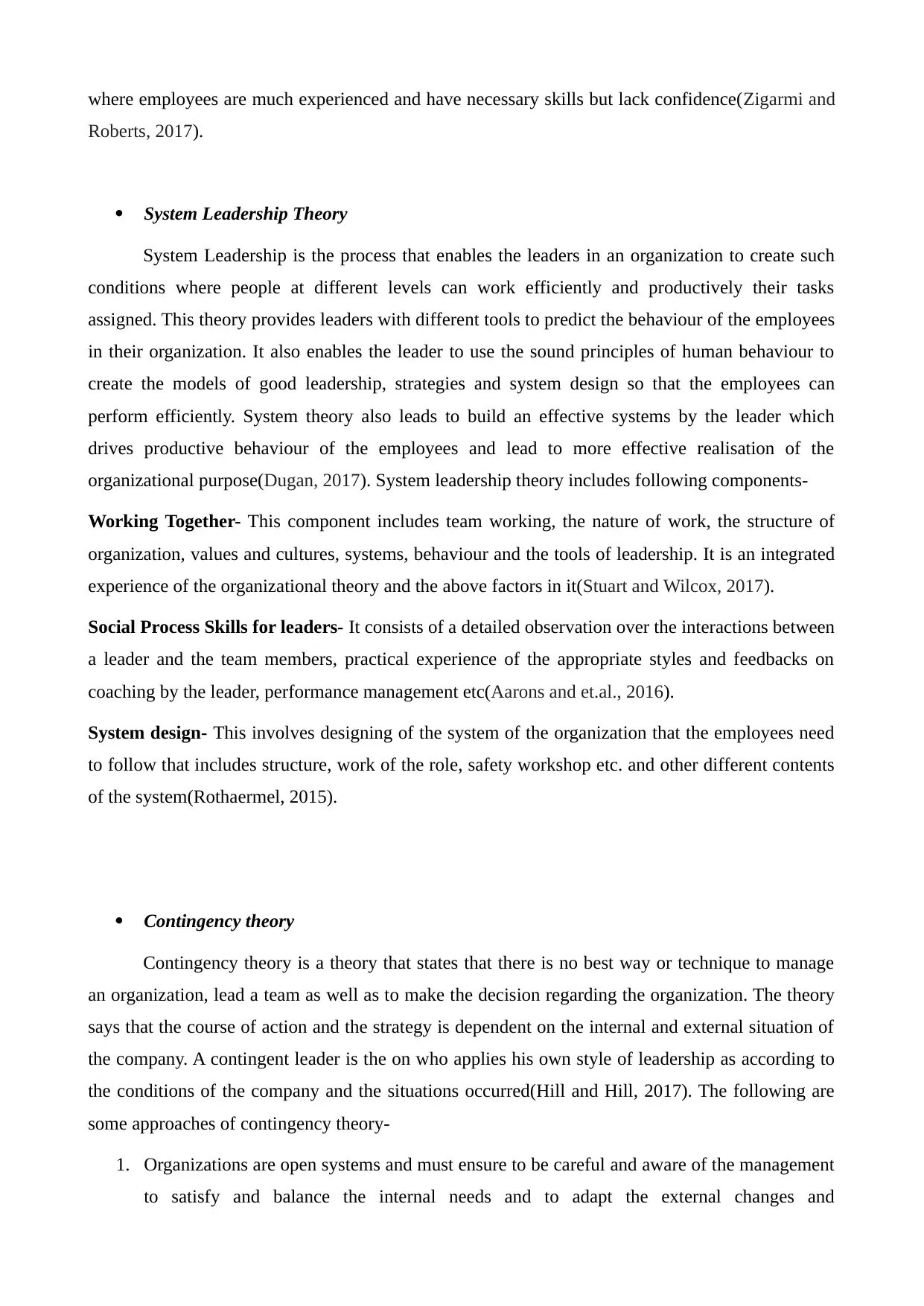
where employees are much experienced and have necessary skills but lack confidence(Zigarmi and
Roberts, 2017).
System Leadership Theory
System Leadership is the process that enables the leaders in an organization to create such
conditions where people at different levels can work efficiently and productively their tasks
assigned. This theory provides leaders with different tools to predict the behaviour of the employees
in their organization. It also enables the leader to use the sound principles of human behaviour to
create the models of good leadership, strategies and system design so that the employees can
perform efficiently. System theory also leads to build an effective systems by the leader which
drives productive behaviour of the employees and lead to more effective realisation of the
organizational purpose(Dugan, 2017). System leadership theory includes following components-
Working Together- This component includes team working, the nature of work, the structure of
organization, values and cultures, systems, behaviour and the tools of leadership. It is an integrated
experience of the organizational theory and the above factors in it(Stuart and Wilcox, 2017).
Social Process Skills for leaders- It consists of a detailed observation over the interactions between
a leader and the team members, practical experience of the appropriate styles and feedbacks on
coaching by the leader, performance management etc(Aarons and et.al., 2016).
System design- This involves designing of the system of the organization that the employees need
to follow that includes structure, work of the role, safety workshop etc. and other different contents
of the system(Rothaermel, 2015).
Contingency theory
Contingency theory is a theory that states that there is no best way or technique to manage
an organization, lead a team as well as to make the decision regarding the organization. The theory
says that the course of action and the strategy is dependent on the internal and external situation of
the company. A contingent leader is the on who applies his own style of leadership as according to
the conditions of the company and the situations occurred(Hill and Hill, 2017). The following are
some approaches of contingency theory-
1. Organizations are open systems and must ensure to be careful and aware of the management
to satisfy and balance the internal needs and to adapt the external changes and
Roberts, 2017).
System Leadership Theory
System Leadership is the process that enables the leaders in an organization to create such
conditions where people at different levels can work efficiently and productively their tasks
assigned. This theory provides leaders with different tools to predict the behaviour of the employees
in their organization. It also enables the leader to use the sound principles of human behaviour to
create the models of good leadership, strategies and system design so that the employees can
perform efficiently. System theory also leads to build an effective systems by the leader which
drives productive behaviour of the employees and lead to more effective realisation of the
organizational purpose(Dugan, 2017). System leadership theory includes following components-
Working Together- This component includes team working, the nature of work, the structure of
organization, values and cultures, systems, behaviour and the tools of leadership. It is an integrated
experience of the organizational theory and the above factors in it(Stuart and Wilcox, 2017).
Social Process Skills for leaders- It consists of a detailed observation over the interactions between
a leader and the team members, practical experience of the appropriate styles and feedbacks on
coaching by the leader, performance management etc(Aarons and et.al., 2016).
System design- This involves designing of the system of the organization that the employees need
to follow that includes structure, work of the role, safety workshop etc. and other different contents
of the system(Rothaermel, 2015).
Contingency theory
Contingency theory is a theory that states that there is no best way or technique to manage
an organization, lead a team as well as to make the decision regarding the organization. The theory
says that the course of action and the strategy is dependent on the internal and external situation of
the company. A contingent leader is the on who applies his own style of leadership as according to
the conditions of the company and the situations occurred(Hill and Hill, 2017). The following are
some approaches of contingency theory-
1. Organizations are open systems and must ensure to be careful and aware of the management
to satisfy and balance the internal needs and to adapt the external changes and
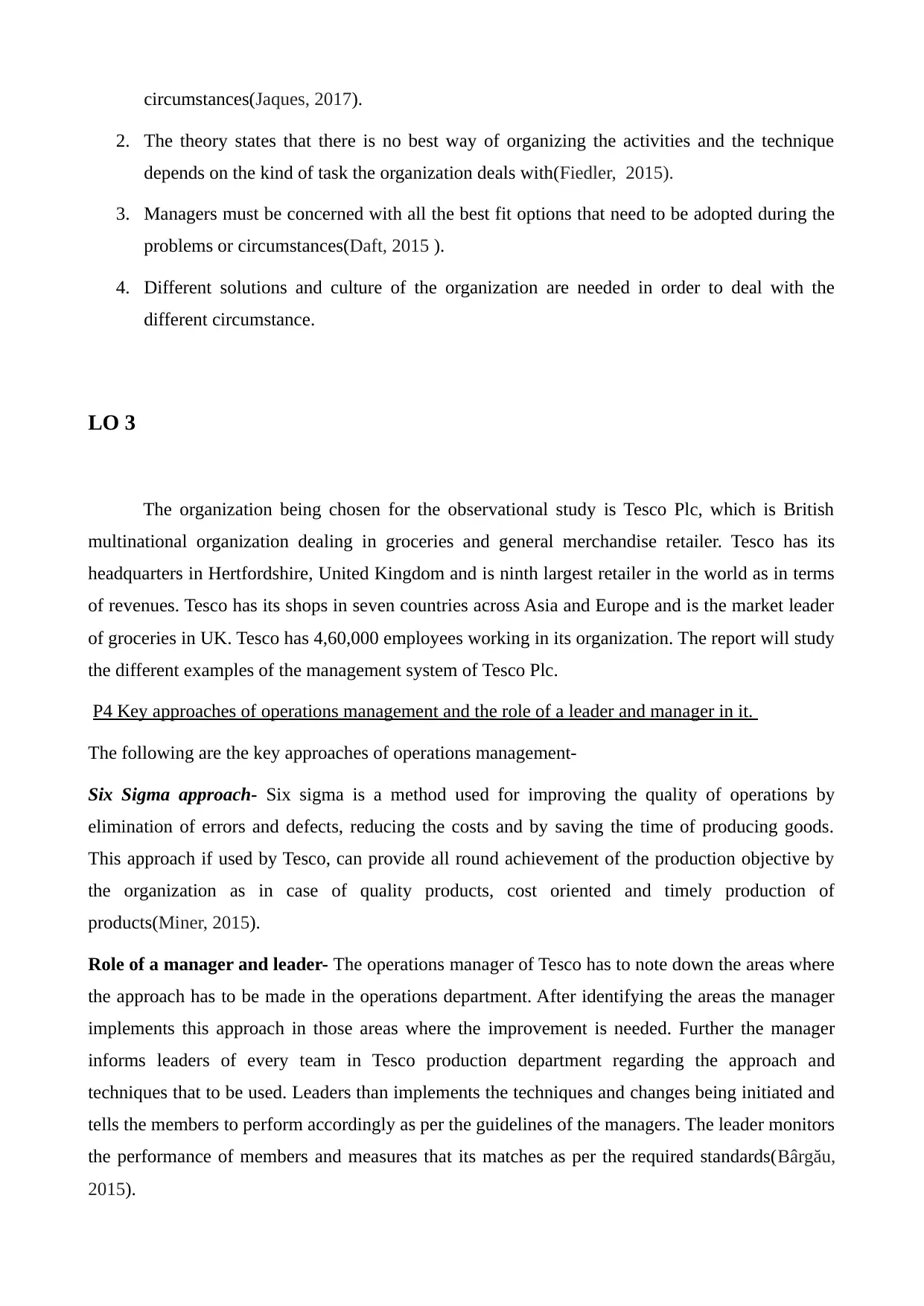
circumstances(Jaques, 2017).
2. The theory states that there is no best way of organizing the activities and the technique
depends on the kind of task the organization deals with(Fiedler, 2015).
3. Managers must be concerned with all the best fit options that need to be adopted during the
problems or circumstances(Daft, 2015 ).
4. Different solutions and culture of the organization are needed in order to deal with the
different circumstance.
LO 3
The organization being chosen for the observational study is Tesco Plc, which is British
multinational organization dealing in groceries and general merchandise retailer. Tesco has its
headquarters in Hertfordshire, United Kingdom and is ninth largest retailer in the world as in terms
of revenues. Tesco has its shops in seven countries across Asia and Europe and is the market leader
of groceries in UK. Tesco has 4,60,000 employees working in its organization. The report will study
the different examples of the management system of Tesco Plc.
P4 Key approaches of operations management and the role of a leader and manager in it.
The following are the key approaches of operations management-
Six Sigma approach- Six sigma is a method used for improving the quality of operations by
elimination of errors and defects, reducing the costs and by saving the time of producing goods.
This approach if used by Tesco, can provide all round achievement of the production objective by
the organization as in case of quality products, cost oriented and timely production of
products(Miner, 2015).
Role of a manager and leader- The operations manager of Tesco has to note down the areas where
the approach has to be made in the operations department. After identifying the areas the manager
implements this approach in those areas where the improvement is needed. Further the manager
informs leaders of every team in Tesco production department regarding the approach and
techniques that to be used. Leaders than implements the techniques and changes being initiated and
tells the members to perform accordingly as per the guidelines of the managers. The leader monitors
the performance of members and measures that its matches as per the required standards(Bârgău,
2015).
2. The theory states that there is no best way of organizing the activities and the technique
depends on the kind of task the organization deals with(Fiedler, 2015).
3. Managers must be concerned with all the best fit options that need to be adopted during the
problems or circumstances(Daft, 2015 ).
4. Different solutions and culture of the organization are needed in order to deal with the
different circumstance.
LO 3
The organization being chosen for the observational study is Tesco Plc, which is British
multinational organization dealing in groceries and general merchandise retailer. Tesco has its
headquarters in Hertfordshire, United Kingdom and is ninth largest retailer in the world as in terms
of revenues. Tesco has its shops in seven countries across Asia and Europe and is the market leader
of groceries in UK. Tesco has 4,60,000 employees working in its organization. The report will study
the different examples of the management system of Tesco Plc.
P4 Key approaches of operations management and the role of a leader and manager in it.
The following are the key approaches of operations management-
Six Sigma approach- Six sigma is a method used for improving the quality of operations by
elimination of errors and defects, reducing the costs and by saving the time of producing goods.
This approach if used by Tesco, can provide all round achievement of the production objective by
the organization as in case of quality products, cost oriented and timely production of
products(Miner, 2015).
Role of a manager and leader- The operations manager of Tesco has to note down the areas where
the approach has to be made in the operations department. After identifying the areas the manager
implements this approach in those areas where the improvement is needed. Further the manager
informs leaders of every team in Tesco production department regarding the approach and
techniques that to be used. Leaders than implements the techniques and changes being initiated and
tells the members to perform accordingly as per the guidelines of the managers. The leader monitors
the performance of members and measures that its matches as per the required standards(Bârgău,
2015).
⊘ This is a preview!⊘
Do you want full access?
Subscribe today to unlock all pages.

Trusted by 1+ million students worldwide
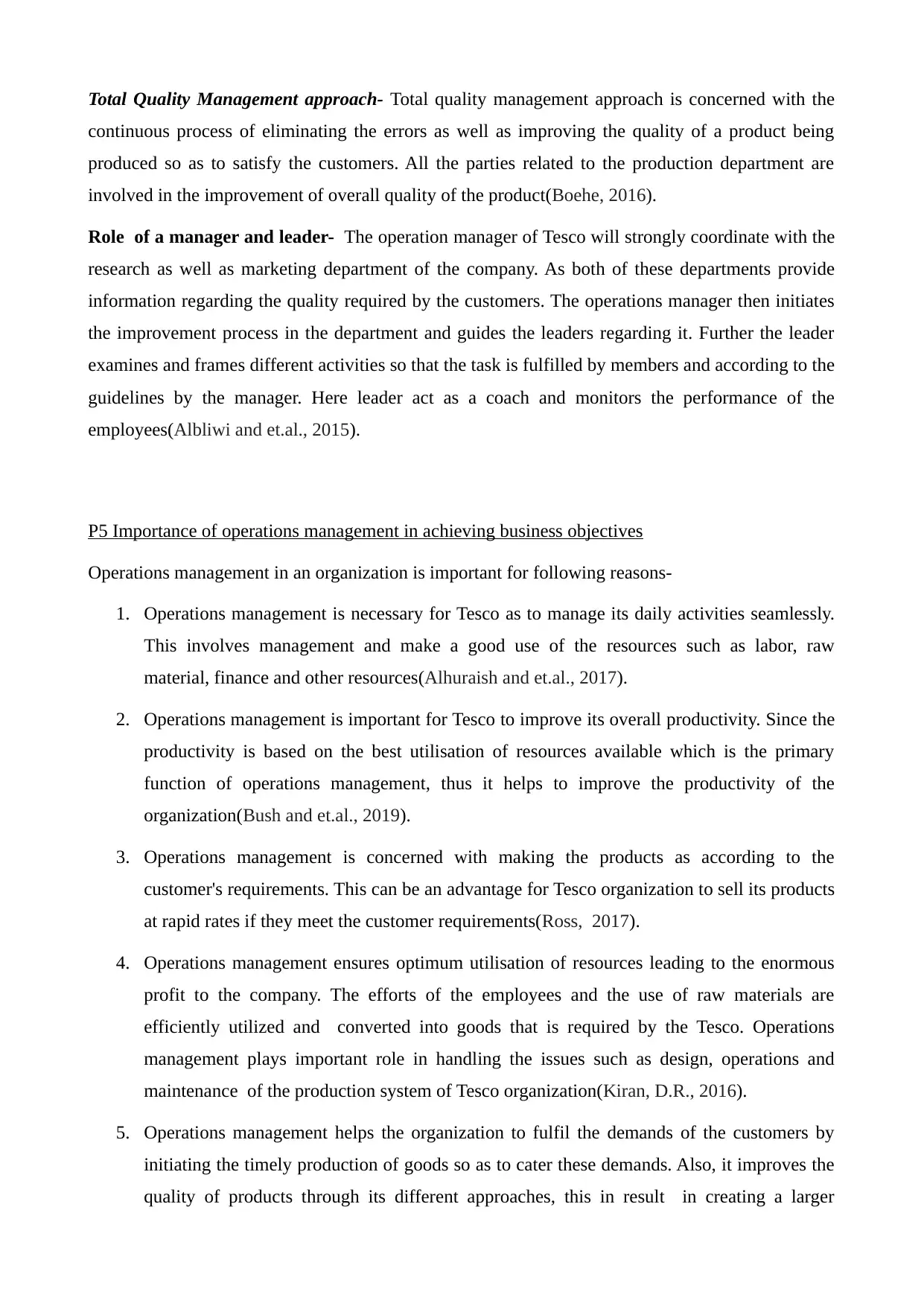
Total Quality Management approach- Total quality management approach is concerned with the
continuous process of eliminating the errors as well as improving the quality of a product being
produced so as to satisfy the customers. All the parties related to the production department are
involved in the improvement of overall quality of the product(Boehe, 2016).
Role of a manager and leader- The operation manager of Tesco will strongly coordinate with the
research as well as marketing department of the company. As both of these departments provide
information regarding the quality required by the customers. The operations manager then initiates
the improvement process in the department and guides the leaders regarding it. Further the leader
examines and frames different activities so that the task is fulfilled by members and according to the
guidelines by the manager. Here leader act as a coach and monitors the performance of the
employees(Albliwi and et.al., 2015).
P5 Importance of operations management in achieving business objectives
Operations management in an organization is important for following reasons-
1. Operations management is necessary for Tesco as to manage its daily activities seamlessly.
This involves management and make a good use of the resources such as labor, raw
material, finance and other resources(Alhuraish and et.al., 2017).
2. Operations management is important for Tesco to improve its overall productivity. Since the
productivity is based on the best utilisation of resources available which is the primary
function of operations management, thus it helps to improve the productivity of the
organization(Bush and et.al., 2019).
3. Operations management is concerned with making the products as according to the
customer's requirements. This can be an advantage for Tesco organization to sell its products
at rapid rates if they meet the customer requirements(Ross, 2017).
4. Operations management ensures optimum utilisation of resources leading to the enormous
profit to the company. The efforts of the employees and the use of raw materials are
efficiently utilized and converted into goods that is required by the Tesco. Operations
management plays important role in handling the issues such as design, operations and
maintenance of the production system of Tesco organization(Kiran, D.R., 2016).
5. Operations management helps the organization to fulfil the demands of the customers by
initiating the timely production of goods so as to cater these demands. Also, it improves the
quality of products through its different approaches, this in result in creating a larger
continuous process of eliminating the errors as well as improving the quality of a product being
produced so as to satisfy the customers. All the parties related to the production department are
involved in the improvement of overall quality of the product(Boehe, 2016).
Role of a manager and leader- The operation manager of Tesco will strongly coordinate with the
research as well as marketing department of the company. As both of these departments provide
information regarding the quality required by the customers. The operations manager then initiates
the improvement process in the department and guides the leaders regarding it. Further the leader
examines and frames different activities so that the task is fulfilled by members and according to the
guidelines by the manager. Here leader act as a coach and monitors the performance of the
employees(Albliwi and et.al., 2015).
P5 Importance of operations management in achieving business objectives
Operations management in an organization is important for following reasons-
1. Operations management is necessary for Tesco as to manage its daily activities seamlessly.
This involves management and make a good use of the resources such as labor, raw
material, finance and other resources(Alhuraish and et.al., 2017).
2. Operations management is important for Tesco to improve its overall productivity. Since the
productivity is based on the best utilisation of resources available which is the primary
function of operations management, thus it helps to improve the productivity of the
organization(Bush and et.al., 2019).
3. Operations management is concerned with making the products as according to the
customer's requirements. This can be an advantage for Tesco organization to sell its products
at rapid rates if they meet the customer requirements(Ross, 2017).
4. Operations management ensures optimum utilisation of resources leading to the enormous
profit to the company. The efforts of the employees and the use of raw materials are
efficiently utilized and converted into goods that is required by the Tesco. Operations
management plays important role in handling the issues such as design, operations and
maintenance of the production system of Tesco organization(Kiran, D.R., 2016).
5. Operations management helps the organization to fulfil the demands of the customers by
initiating the timely production of goods so as to cater these demands. Also, it improves the
quality of products through its different approaches, this in result in creating a larger
Paraphrase This Document
Need a fresh take? Get an instant paraphrase of this document with our AI Paraphraser
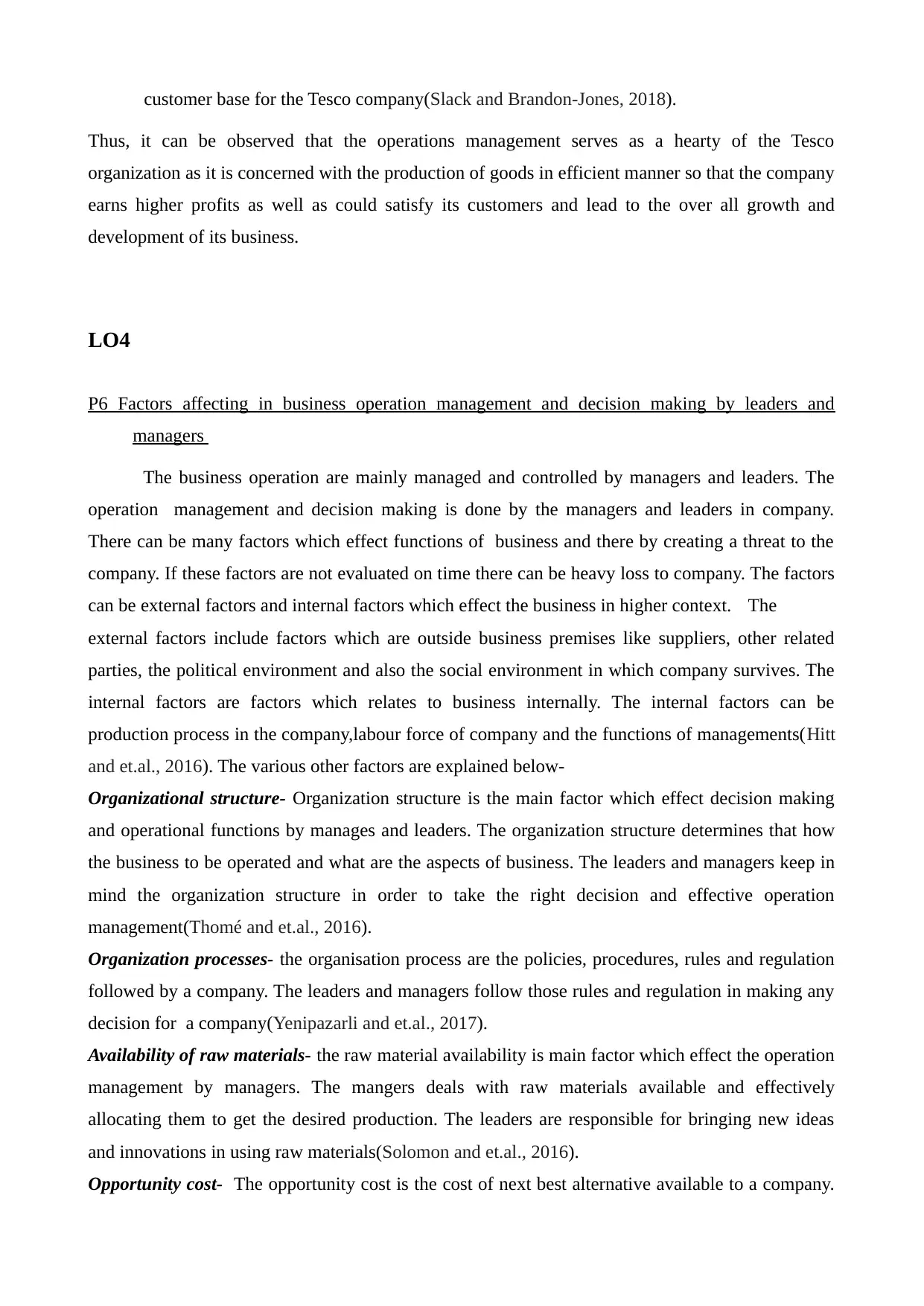
customer base for the Tesco company(Slack and Brandon-Jones, 2018).
Thus, it can be observed that the operations management serves as a hearty of the Tesco
organization as it is concerned with the production of goods in efficient manner so that the company
earns higher profits as well as could satisfy its customers and lead to the over all growth and
development of its business.
LO4
P6 Factors affecting in business operation management and decision making by leaders and
managers
The business operation are mainly managed and controlled by managers and leaders. The
operation management and decision making is done by the managers and leaders in company.
There can be many factors which effect functions of business and there by creating a threat to the
company. If these factors are not evaluated on time there can be heavy loss to company. The factors
can be external factors and internal factors which effect the business in higher context. The
external factors include factors which are outside business premises like suppliers, other related
parties, the political environment and also the social environment in which company survives. The
internal factors are factors which relates to business internally. The internal factors can be
production process in the company,labour force of company and the functions of managements(Hitt
and et.al., 2016). The various other factors are explained below-
Organizational structure- Organization structure is the main factor which effect decision making
and operational functions by manages and leaders. The organization structure determines that how
the business to be operated and what are the aspects of business. The leaders and managers keep in
mind the organization structure in order to take the right decision and effective operation
management(Thomé and et.al., 2016).
Organization processes- the organisation process are the policies, procedures, rules and regulation
followed by a company. The leaders and managers follow those rules and regulation in making any
decision for a company(Yenipazarli and et.al., 2017).
Availability of raw materials- the raw material availability is main factor which effect the operation
management by managers. The mangers deals with raw materials available and effectively
allocating them to get the desired production. The leaders are responsible for bringing new ideas
and innovations in using raw materials(Solomon and et.al., 2016).
Opportunity cost- The opportunity cost is the cost of next best alternative available to a company.
Thus, it can be observed that the operations management serves as a hearty of the Tesco
organization as it is concerned with the production of goods in efficient manner so that the company
earns higher profits as well as could satisfy its customers and lead to the over all growth and
development of its business.
LO4
P6 Factors affecting in business operation management and decision making by leaders and
managers
The business operation are mainly managed and controlled by managers and leaders. The
operation management and decision making is done by the managers and leaders in company.
There can be many factors which effect functions of business and there by creating a threat to the
company. If these factors are not evaluated on time there can be heavy loss to company. The factors
can be external factors and internal factors which effect the business in higher context. The
external factors include factors which are outside business premises like suppliers, other related
parties, the political environment and also the social environment in which company survives. The
internal factors are factors which relates to business internally. The internal factors can be
production process in the company,labour force of company and the functions of managements(Hitt
and et.al., 2016). The various other factors are explained below-
Organizational structure- Organization structure is the main factor which effect decision making
and operational functions by manages and leaders. The organization structure determines that how
the business to be operated and what are the aspects of business. The leaders and managers keep in
mind the organization structure in order to take the right decision and effective operation
management(Thomé and et.al., 2016).
Organization processes- the organisation process are the policies, procedures, rules and regulation
followed by a company. The leaders and managers follow those rules and regulation in making any
decision for a company(Yenipazarli and et.al., 2017).
Availability of raw materials- the raw material availability is main factor which effect the operation
management by managers. The mangers deals with raw materials available and effectively
allocating them to get the desired production. The leaders are responsible for bringing new ideas
and innovations in using raw materials(Solomon and et.al., 2016).
Opportunity cost- The opportunity cost is the cost of next best alternative available to a company.
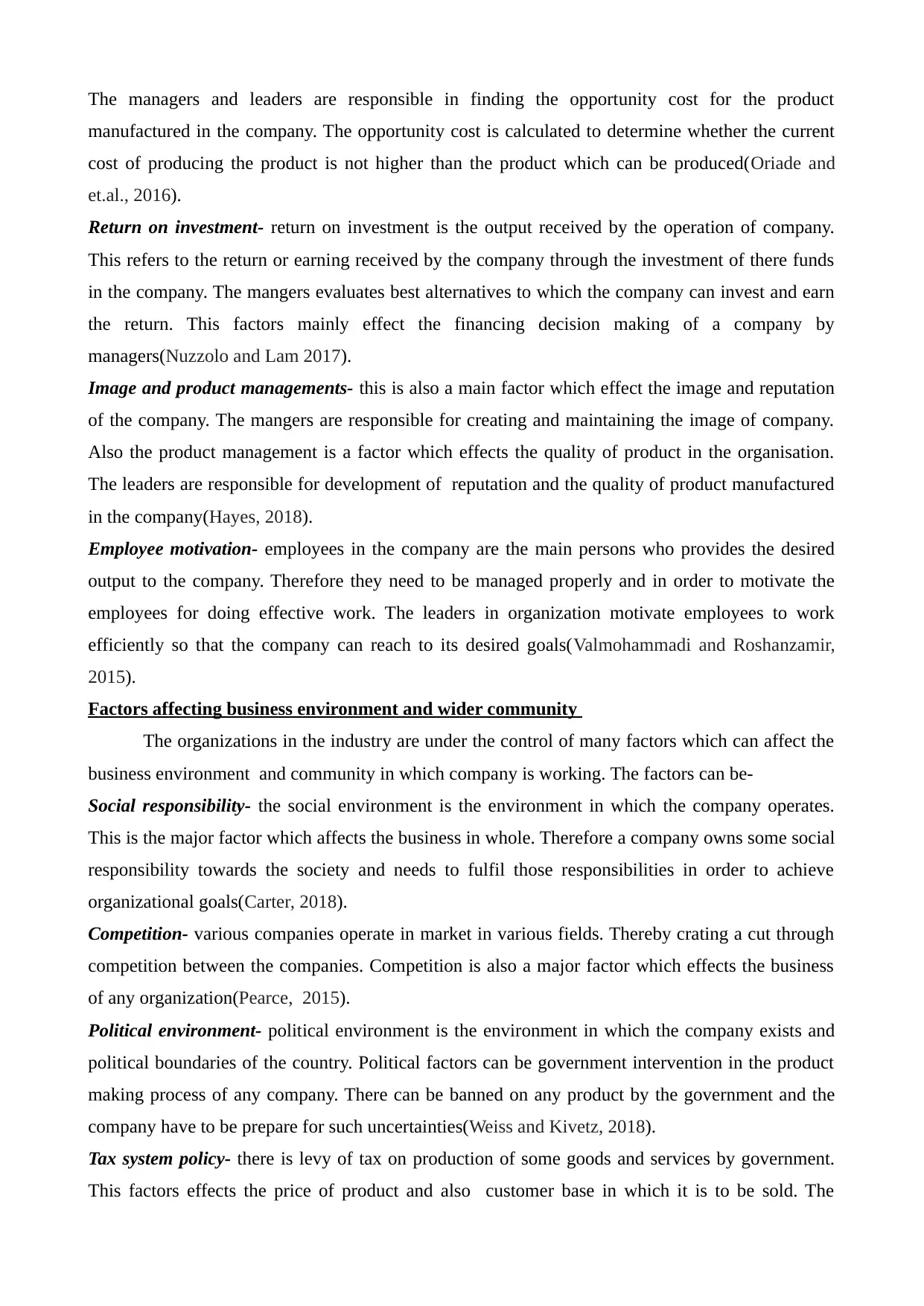
The managers and leaders are responsible in finding the opportunity cost for the product
manufactured in the company. The opportunity cost is calculated to determine whether the current
cost of producing the product is not higher than the product which can be produced(Oriade and
et.al., 2016).
Return on investment- return on investment is the output received by the operation of company.
This refers to the return or earning received by the company through the investment of there funds
in the company. The mangers evaluates best alternatives to which the company can invest and earn
the return. This factors mainly effect the financing decision making of a company by
managers(Nuzzolo and Lam 2017).
Image and product managements- this is also a main factor which effect the image and reputation
of the company. The mangers are responsible for creating and maintaining the image of company.
Also the product management is a factor which effects the quality of product in the organisation.
The leaders are responsible for development of reputation and the quality of product manufactured
in the company(Hayes, 2018).
Employee motivation- employees in the company are the main persons who provides the desired
output to the company. Therefore they need to be managed properly and in order to motivate the
employees for doing effective work. The leaders in organization motivate employees to work
efficiently so that the company can reach to its desired goals(Valmohammadi and Roshanzamir,
2015).
Factors affecting business environment and wider community
The organizations in the industry are under the control of many factors which can affect the
business environment and community in which company is working. The factors can be-
Social responsibility- the social environment is the environment in which the company operates.
This is the major factor which affects the business in whole. Therefore a company owns some social
responsibility towards the society and needs to fulfil those responsibilities in order to achieve
organizational goals(Carter, 2018).
Competition- various companies operate in market in various fields. Thereby crating a cut through
competition between the companies. Competition is also a major factor which effects the business
of any organization(Pearce, 2015).
Political environment- political environment is the environment in which the company exists and
political boundaries of the country. Political factors can be government intervention in the product
making process of any company. There can be banned on any product by the government and the
company have to be prepare for such uncertainties(Weiss and Kivetz, 2018).
Tax system policy- there is levy of tax on production of some goods and services by government.
This factors effects the price of product and also customer base in which it is to be sold. The
manufactured in the company. The opportunity cost is calculated to determine whether the current
cost of producing the product is not higher than the product which can be produced(Oriade and
et.al., 2016).
Return on investment- return on investment is the output received by the operation of company.
This refers to the return or earning received by the company through the investment of there funds
in the company. The mangers evaluates best alternatives to which the company can invest and earn
the return. This factors mainly effect the financing decision making of a company by
managers(Nuzzolo and Lam 2017).
Image and product managements- this is also a main factor which effect the image and reputation
of the company. The mangers are responsible for creating and maintaining the image of company.
Also the product management is a factor which effects the quality of product in the organisation.
The leaders are responsible for development of reputation and the quality of product manufactured
in the company(Hayes, 2018).
Employee motivation- employees in the company are the main persons who provides the desired
output to the company. Therefore they need to be managed properly and in order to motivate the
employees for doing effective work. The leaders in organization motivate employees to work
efficiently so that the company can reach to its desired goals(Valmohammadi and Roshanzamir,
2015).
Factors affecting business environment and wider community
The organizations in the industry are under the control of many factors which can affect the
business environment and community in which company is working. The factors can be-
Social responsibility- the social environment is the environment in which the company operates.
This is the major factor which affects the business in whole. Therefore a company owns some social
responsibility towards the society and needs to fulfil those responsibilities in order to achieve
organizational goals(Carter, 2018).
Competition- various companies operate in market in various fields. Thereby crating a cut through
competition between the companies. Competition is also a major factor which effects the business
of any organization(Pearce, 2015).
Political environment- political environment is the environment in which the company exists and
political boundaries of the country. Political factors can be government intervention in the product
making process of any company. There can be banned on any product by the government and the
company have to be prepare for such uncertainties(Weiss and Kivetz, 2018).
Tax system policy- there is levy of tax on production of some goods and services by government.
This factors effects the price of product and also customer base in which it is to be sold. The
⊘ This is a preview!⊘
Do you want full access?
Subscribe today to unlock all pages.

Trusted by 1+ million students worldwide
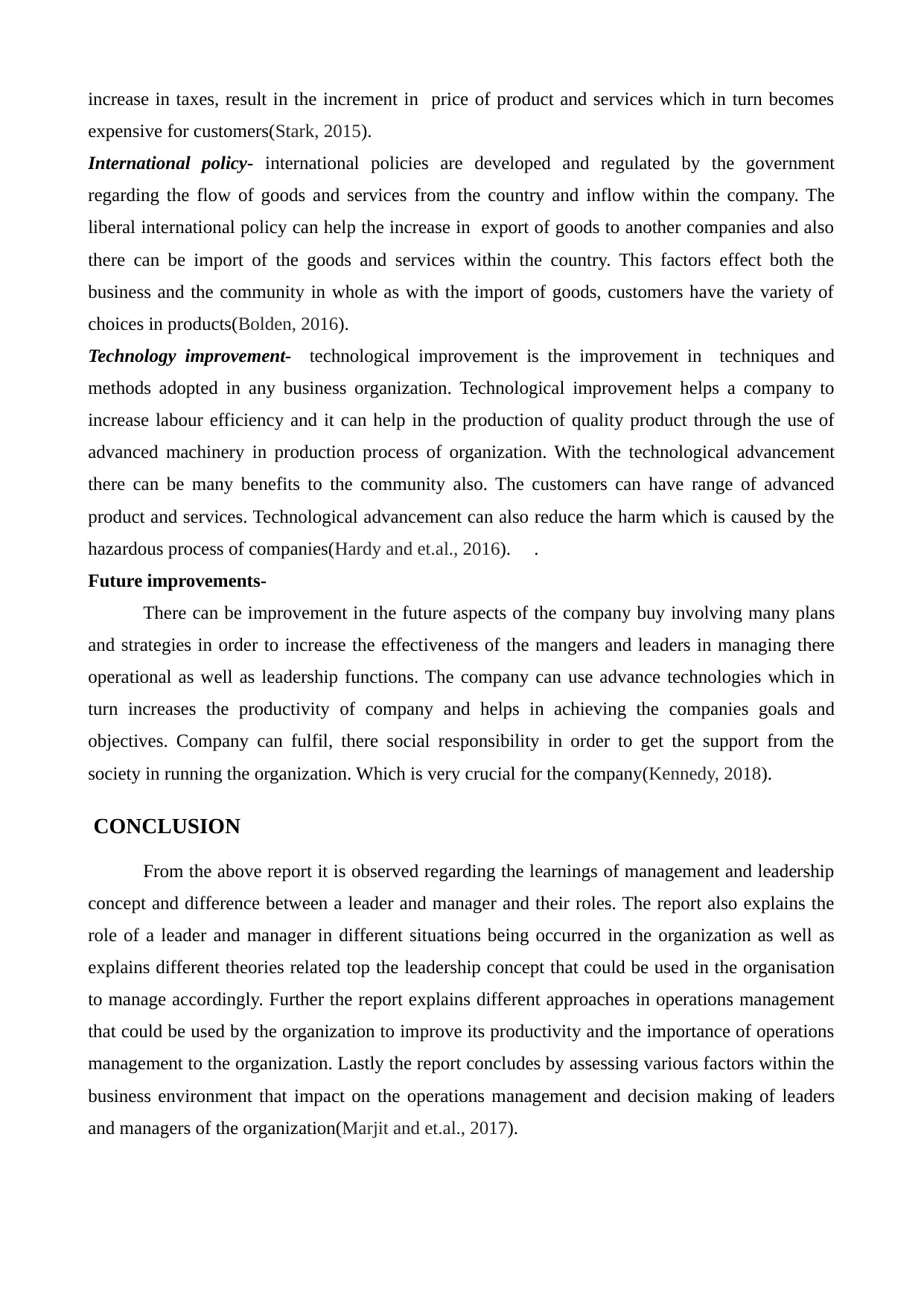
increase in taxes, result in the increment in price of product and services which in turn becomes
expensive for customers(Stark, 2015).
International policy- international policies are developed and regulated by the government
regarding the flow of goods and services from the country and inflow within the company. The
liberal international policy can help the increase in export of goods to another companies and also
there can be import of the goods and services within the country. This factors effect both the
business and the community in whole as with the import of goods, customers have the variety of
choices in products(Bolden, 2016).
Technology improvement- technological improvement is the improvement in techniques and
methods adopted in any business organization. Technological improvement helps a company to
increase labour efficiency and it can help in the production of quality product through the use of
advanced machinery in production process of organization. With the technological advancement
there can be many benefits to the community also. The customers can have range of advanced
product and services. Technological advancement can also reduce the harm which is caused by the
hazardous process of companies(Hardy and et.al., 2016). .
Future improvements-
There can be improvement in the future aspects of the company buy involving many plans
and strategies in order to increase the effectiveness of the mangers and leaders in managing there
operational as well as leadership functions. The company can use advance technologies which in
turn increases the productivity of company and helps in achieving the companies goals and
objectives. Company can fulfil, there social responsibility in order to get the support from the
society in running the organization. Which is very crucial for the company(Kennedy, 2018).
CONCLUSION
From the above report it is observed regarding the learnings of management and leadership
concept and difference between a leader and manager and their roles. The report also explains the
role of a leader and manager in different situations being occurred in the organization as well as
explains different theories related top the leadership concept that could be used in the organisation
to manage accordingly. Further the report explains different approaches in operations management
that could be used by the organization to improve its productivity and the importance of operations
management to the organization. Lastly the report concludes by assessing various factors within the
business environment that impact on the operations management and decision making of leaders
and managers of the organization(Marjit and et.al., 2017).
expensive for customers(Stark, 2015).
International policy- international policies are developed and regulated by the government
regarding the flow of goods and services from the country and inflow within the company. The
liberal international policy can help the increase in export of goods to another companies and also
there can be import of the goods and services within the country. This factors effect both the
business and the community in whole as with the import of goods, customers have the variety of
choices in products(Bolden, 2016).
Technology improvement- technological improvement is the improvement in techniques and
methods adopted in any business organization. Technological improvement helps a company to
increase labour efficiency and it can help in the production of quality product through the use of
advanced machinery in production process of organization. With the technological advancement
there can be many benefits to the community also. The customers can have range of advanced
product and services. Technological advancement can also reduce the harm which is caused by the
hazardous process of companies(Hardy and et.al., 2016). .
Future improvements-
There can be improvement in the future aspects of the company buy involving many plans
and strategies in order to increase the effectiveness of the mangers and leaders in managing there
operational as well as leadership functions. The company can use advance technologies which in
turn increases the productivity of company and helps in achieving the companies goals and
objectives. Company can fulfil, there social responsibility in order to get the support from the
society in running the organization. Which is very crucial for the company(Kennedy, 2018).
CONCLUSION
From the above report it is observed regarding the learnings of management and leadership
concept and difference between a leader and manager and their roles. The report also explains the
role of a leader and manager in different situations being occurred in the organization as well as
explains different theories related top the leadership concept that could be used in the organisation
to manage accordingly. Further the report explains different approaches in operations management
that could be used by the organization to improve its productivity and the importance of operations
management to the organization. Lastly the report concludes by assessing various factors within the
business environment that impact on the operations management and decision making of leaders
and managers of the organization(Marjit and et.al., 2017).
Paraphrase This Document
Need a fresh take? Get an instant paraphrase of this document with our AI Paraphraser

REFERENCES
Books and Journals
Aarons, G.A and et.al., 2016. The roles of system and organizational leadership in system-wide
evidence-based intervention sustainment: a mixed-method study. Administration and
Policy in Mental Health and Mental Health Services Research. 43(6). pp.991-1008.
Alavi, S.B. and Gill, C., 2017. Leading change authentically: How authentic leaders influence
follower responses to complex change. Journal of Leadership & Organizational Studies.
24(2). pp.157-171.
Albliwi, S.A and et.al., 2015. A systematic review of Lean Six Sigma for the manufacturing
industry.Business Process Management Journal. 21(3). pp.665-691.
Alhuraish, I and et.al., 2017. A comparative exploration of lean manufacturing and six sigma in
Books and Journals
Aarons, G.A and et.al., 2016. The roles of system and organizational leadership in system-wide
evidence-based intervention sustainment: a mixed-method study. Administration and
Policy in Mental Health and Mental Health Services Research. 43(6). pp.991-1008.
Alavi, S.B. and Gill, C., 2017. Leading change authentically: How authentic leaders influence
follower responses to complex change. Journal of Leadership & Organizational Studies.
24(2). pp.157-171.
Albliwi, S.A and et.al., 2015. A systematic review of Lean Six Sigma for the manufacturing
industry.Business Process Management Journal. 21(3). pp.665-691.
Alhuraish, I and et.al., 2017. A comparative exploration of lean manufacturing and six sigma in

terms of their critical success factors. Journal of cleaner production.164. pp.325-337.
Bârgău, M.A., 2015. Leadership versus management. Romanian Economic and Business
Review. 10(2). p.112135.
Boehe, D.M., 2016. Supervisory styles: A contingency framework. Studies in Higher Education.
41(3). pp.399-414.
Bolden, R., 2016. Leadership, management and organisational development. In Gower handbook
of leadership and management development (pp. 143-158). Routledge.
Booth, S.A., 2015. Crisis management strategy: Competition and change in modern enterprises.
Routledge.
Bundy, J and et.al., 2017. Crises and crisis management: Integration, interpretation, and research
development. Journal of Management. 43(6). pp.1661-1692.
Bush, T and et.al., 2019. Principles of Educational Leadership & Management. SAGE
Publications Limited.
Carter, N., 2018. The politics of the environment: Ideas, activism, policy. Cambridge University
Press.
Chiu, C.Y.C and et.al., 2017. When managers become leaders: The role of manager network
centralities, social power, and followers' perception of leadership. The Leadership
Quarterly. 28(2). pp.334-348.
Chow, A.T. and Moseley, J.L., 2017. Comparisons of Six Sigma, Lean, and Human Performance
Technology/Performance Improvement. Performance Improvement.56(1). pp.6-13.
Daft, R.L., 2015 Organization theory and design. Cengage learning.
Dugan, J.P., 2017. Leadership theory: Cultivating critical perspectives. John Wiley & Sons.
Fiedler, F.R.E.D., 2015. Contingency theory of leadership.Organizational Behavior 1: Essential
Theories of Motivation and Leadership. 232. pp.01-2015.
Hardy, S.N and et.al., 2016. Product management display system. U.S. Patent 9,486,088.
Hayes, J., 2018. The theory and practice of change management. Palgrave.
Heizer, J., 2016. Operations management, 11/e. Pearson Education India.
Hill, A. and Hill, T., 2017. Essential operations management. Macmillan International Higher
Education.
Hitt, M.A and et.al., 2016. Resource based theory in operations management research. Journal of
Bârgău, M.A., 2015. Leadership versus management. Romanian Economic and Business
Review. 10(2). p.112135.
Boehe, D.M., 2016. Supervisory styles: A contingency framework. Studies in Higher Education.
41(3). pp.399-414.
Bolden, R., 2016. Leadership, management and organisational development. In Gower handbook
of leadership and management development (pp. 143-158). Routledge.
Booth, S.A., 2015. Crisis management strategy: Competition and change in modern enterprises.
Routledge.
Bundy, J and et.al., 2017. Crises and crisis management: Integration, interpretation, and research
development. Journal of Management. 43(6). pp.1661-1692.
Bush, T and et.al., 2019. Principles of Educational Leadership & Management. SAGE
Publications Limited.
Carter, N., 2018. The politics of the environment: Ideas, activism, policy. Cambridge University
Press.
Chiu, C.Y.C and et.al., 2017. When managers become leaders: The role of manager network
centralities, social power, and followers' perception of leadership. The Leadership
Quarterly. 28(2). pp.334-348.
Chow, A.T. and Moseley, J.L., 2017. Comparisons of Six Sigma, Lean, and Human Performance
Technology/Performance Improvement. Performance Improvement.56(1). pp.6-13.
Daft, R.L., 2015 Organization theory and design. Cengage learning.
Dugan, J.P., 2017. Leadership theory: Cultivating critical perspectives. John Wiley & Sons.
Fiedler, F.R.E.D., 2015. Contingency theory of leadership.Organizational Behavior 1: Essential
Theories of Motivation and Leadership. 232. pp.01-2015.
Hardy, S.N and et.al., 2016. Product management display system. U.S. Patent 9,486,088.
Hayes, J., 2018. The theory and practice of change management. Palgrave.
Heizer, J., 2016. Operations management, 11/e. Pearson Education India.
Hill, A. and Hill, T., 2017. Essential operations management. Macmillan International Higher
Education.
Hitt, M.A and et.al., 2016. Resource based theory in operations management research. Journal of
⊘ This is a preview!⊘
Do you want full access?
Subscribe today to unlock all pages.

Trusted by 1+ million students worldwide
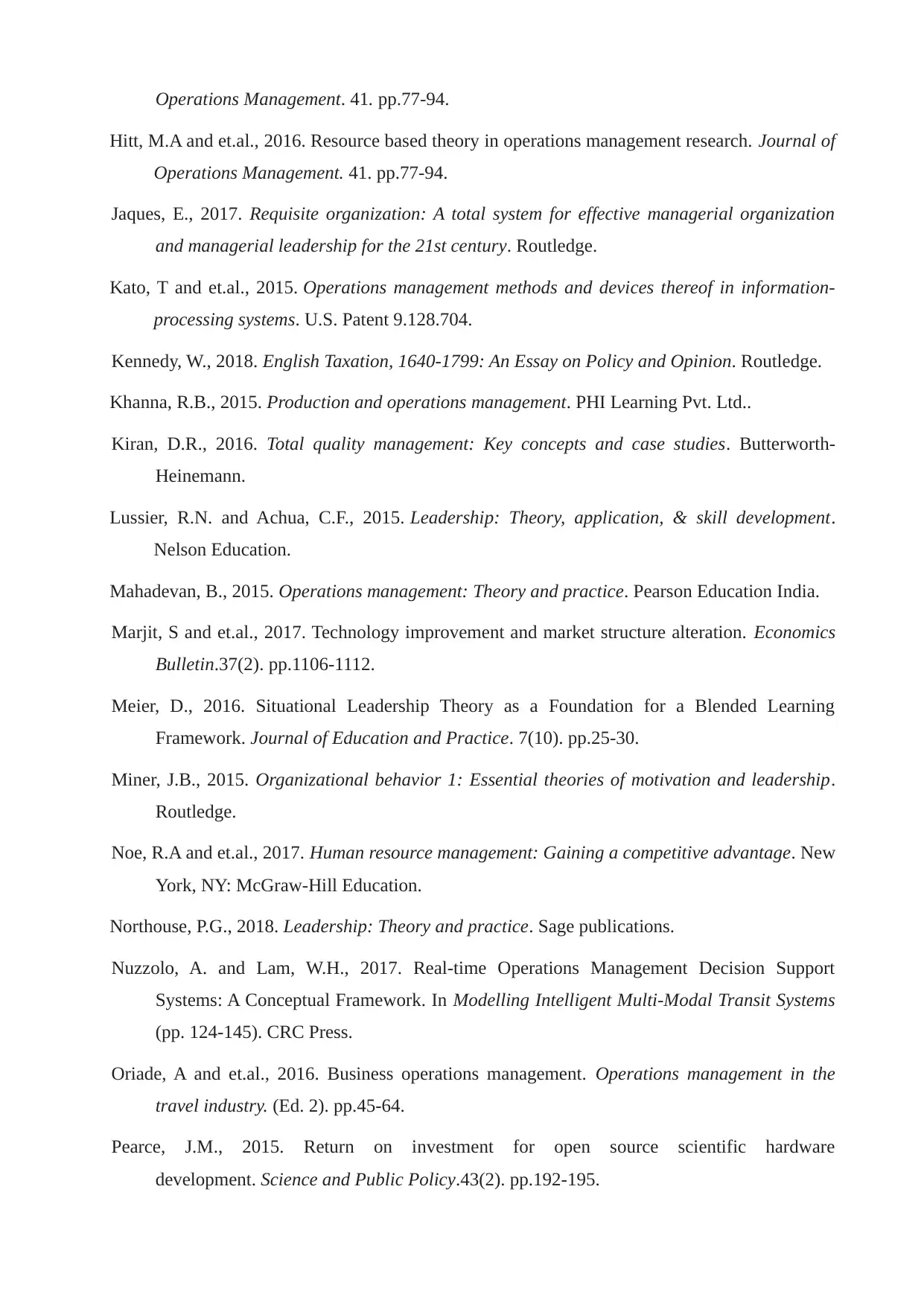
Operations Management. 41. pp.77-94.
Hitt, M.A and et.al., 2016. Resource based theory in operations management research. Journal of
Operations Management. 41. pp.77-94.
Jaques, E., 2017. Requisite organization: A total system for effective managerial organization
and managerial leadership for the 21st century. Routledge.
Kato, T and et.al., 2015. Operations management methods and devices thereof in information-
processing systems. U.S. Patent 9.128.704.
Kennedy, W., 2018. English Taxation, 1640-1799: An Essay on Policy and Opinion. Routledge.
Khanna, R.B., 2015. Production and operations management. PHI Learning Pvt. Ltd..
Kiran, D.R., 2016. Total quality management: Key concepts and case studies. Butterworth-
Heinemann.
Lussier, R.N. and Achua, C.F., 2015. Leadership: Theory, application, & skill development.
Nelson Education.
Mahadevan, B., 2015. Operations management: Theory and practice. Pearson Education India.
Marjit, S and et.al., 2017. Technology improvement and market structure alteration. Economics
Bulletin.37(2). pp.1106-1112.
Meier, D., 2016. Situational Leadership Theory as a Foundation for a Blended Learning
Framework. Journal of Education and Practice. 7(10). pp.25-30.
Miner, J.B., 2015. Organizational behavior 1: Essential theories of motivation and leadership.
Routledge.
Noe, R.A and et.al., 2017. Human resource management: Gaining a competitive advantage. New
York, NY: McGraw-Hill Education.
Northouse, P.G., 2018. Leadership: Theory and practice. Sage publications.
Nuzzolo, A. and Lam, W.H., 2017. Real-time Operations Management Decision Support
Systems: A Conceptual Framework. In Modelling Intelligent Multi-Modal Transit Systems
(pp. 124-145). CRC Press.
Oriade, A and et.al., 2016. Business operations management. Operations management in the
travel industry. (Ed. 2). pp.45-64.
Pearce, J.M., 2015. Return on investment for open source scientific hardware
development. Science and Public Policy.43(2). pp.192-195.
Hitt, M.A and et.al., 2016. Resource based theory in operations management research. Journal of
Operations Management. 41. pp.77-94.
Jaques, E., 2017. Requisite organization: A total system for effective managerial organization
and managerial leadership for the 21st century. Routledge.
Kato, T and et.al., 2015. Operations management methods and devices thereof in information-
processing systems. U.S. Patent 9.128.704.
Kennedy, W., 2018. English Taxation, 1640-1799: An Essay on Policy and Opinion. Routledge.
Khanna, R.B., 2015. Production and operations management. PHI Learning Pvt. Ltd..
Kiran, D.R., 2016. Total quality management: Key concepts and case studies. Butterworth-
Heinemann.
Lussier, R.N. and Achua, C.F., 2015. Leadership: Theory, application, & skill development.
Nelson Education.
Mahadevan, B., 2015. Operations management: Theory and practice. Pearson Education India.
Marjit, S and et.al., 2017. Technology improvement and market structure alteration. Economics
Bulletin.37(2). pp.1106-1112.
Meier, D., 2016. Situational Leadership Theory as a Foundation for a Blended Learning
Framework. Journal of Education and Practice. 7(10). pp.25-30.
Miner, J.B., 2015. Organizational behavior 1: Essential theories of motivation and leadership.
Routledge.
Noe, R.A and et.al., 2017. Human resource management: Gaining a competitive advantage. New
York, NY: McGraw-Hill Education.
Northouse, P.G., 2018. Leadership: Theory and practice. Sage publications.
Nuzzolo, A. and Lam, W.H., 2017. Real-time Operations Management Decision Support
Systems: A Conceptual Framework. In Modelling Intelligent Multi-Modal Transit Systems
(pp. 124-145). CRC Press.
Oriade, A and et.al., 2016. Business operations management. Operations management in the
travel industry. (Ed. 2). pp.45-64.
Pearce, J.M., 2015. Return on investment for open source scientific hardware
development. Science and Public Policy.43(2). pp.192-195.
Paraphrase This Document
Need a fresh take? Get an instant paraphrase of this document with our AI Paraphraser
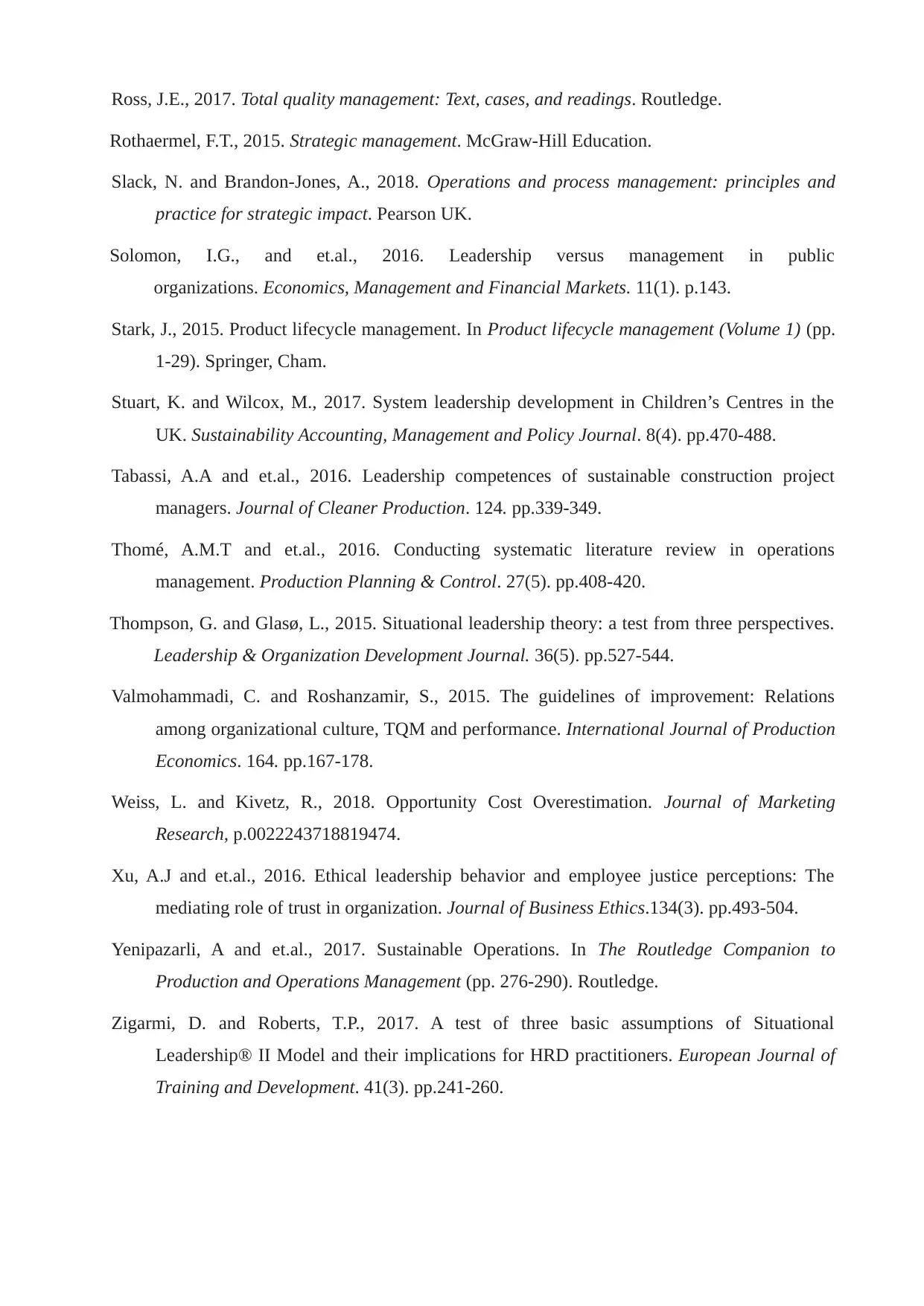
Ross, J.E., 2017. Total quality management: Text, cases, and readings. Routledge.
Rothaermel, F.T., 2015. Strategic management. McGraw-Hill Education.
Slack, N. and Brandon-Jones, A., 2018. Operations and process management: principles and
practice for strategic impact. Pearson UK.
Solomon, I.G., and et.al., 2016. Leadership versus management in public
organizations. Economics, Management and Financial Markets. 11(1). p.143.
Stark, J., 2015. Product lifecycle management. In Product lifecycle management (Volume 1) (pp.
1-29). Springer, Cham.
Stuart, K. and Wilcox, M., 2017. System leadership development in Children’s Centres in the
UK. Sustainability Accounting, Management and Policy Journal. 8(4). pp.470-488.
Tabassi, A.A and et.al., 2016. Leadership competences of sustainable construction project
managers. Journal of Cleaner Production. 124. pp.339-349.
Thomé, A.M.T and et.al., 2016. Conducting systematic literature review in operations
management. Production Planning & Control. 27(5). pp.408-420.
Thompson, G. and Glasø, L., 2015. Situational leadership theory: a test from three perspectives.
Leadership & Organization Development Journal. 36(5). pp.527-544.
Valmohammadi, C. and Roshanzamir, S., 2015. The guidelines of improvement: Relations
among organizational culture, TQM and performance. International Journal of Production
Economics. 164. pp.167-178.
Weiss, L. and Kivetz, R., 2018. Opportunity Cost Overestimation. Journal of Marketing
Research, p.0022243718819474.
Xu, A.J and et.al., 2016. Ethical leadership behavior and employee justice perceptions: The
mediating role of trust in organization. Journal of Business Ethics.134(3). pp.493-504.
Yenipazarli, A and et.al., 2017. Sustainable Operations. In The Routledge Companion to
Production and Operations Management (pp. 276-290). Routledge.
Zigarmi, D. and Roberts, T.P., 2017. A test of three basic assumptions of Situational
Leadership® II Model and their implications for HRD practitioners. European Journal of
Training and Development. 41(3). pp.241-260.
Rothaermel, F.T., 2015. Strategic management. McGraw-Hill Education.
Slack, N. and Brandon-Jones, A., 2018. Operations and process management: principles and
practice for strategic impact. Pearson UK.
Solomon, I.G., and et.al., 2016. Leadership versus management in public
organizations. Economics, Management and Financial Markets. 11(1). p.143.
Stark, J., 2015. Product lifecycle management. In Product lifecycle management (Volume 1) (pp.
1-29). Springer, Cham.
Stuart, K. and Wilcox, M., 2017. System leadership development in Children’s Centres in the
UK. Sustainability Accounting, Management and Policy Journal. 8(4). pp.470-488.
Tabassi, A.A and et.al., 2016. Leadership competences of sustainable construction project
managers. Journal of Cleaner Production. 124. pp.339-349.
Thomé, A.M.T and et.al., 2016. Conducting systematic literature review in operations
management. Production Planning & Control. 27(5). pp.408-420.
Thompson, G. and Glasø, L., 2015. Situational leadership theory: a test from three perspectives.
Leadership & Organization Development Journal. 36(5). pp.527-544.
Valmohammadi, C. and Roshanzamir, S., 2015. The guidelines of improvement: Relations
among organizational culture, TQM and performance. International Journal of Production
Economics. 164. pp.167-178.
Weiss, L. and Kivetz, R., 2018. Opportunity Cost Overestimation. Journal of Marketing
Research, p.0022243718819474.
Xu, A.J and et.al., 2016. Ethical leadership behavior and employee justice perceptions: The
mediating role of trust in organization. Journal of Business Ethics.134(3). pp.493-504.
Yenipazarli, A and et.al., 2017. Sustainable Operations. In The Routledge Companion to
Production and Operations Management (pp. 276-290). Routledge.
Zigarmi, D. and Roberts, T.P., 2017. A test of three basic assumptions of Situational
Leadership® II Model and their implications for HRD practitioners. European Journal of
Training and Development. 41(3). pp.241-260.
1 out of 17
Related Documents
Your All-in-One AI-Powered Toolkit for Academic Success.
+13062052269
info@desklib.com
Available 24*7 on WhatsApp / Email
![[object Object]](/_next/static/media/star-bottom.7253800d.svg)
Unlock your academic potential
© 2024 | Zucol Services PVT LTD | All rights reserved.





